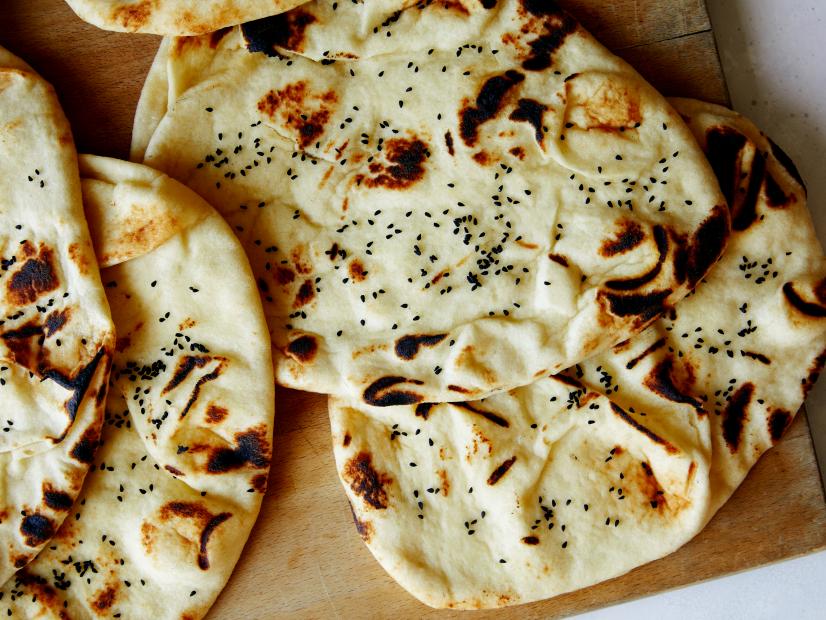
Naan
- Level: Intermediate
- Total: 3 hr (includes rising time)
- Active: 45 min
- Yield: 8 naan
-
- Nutritional Analysis
- Per Serving
- Serving Size
- 1 of 8 servings
- Calories
- 751
- Total Fat
- 63 g
- Saturated Fat
- 8 g
- Carbohydrates
- 40 g
- Dietary Fiber
- 2 g
- Sugar
- 2 g
- Protein
- 8 g
- Cholesterol
- 18 mg
- Sodium
- 248 mg
- Level: Intermediate
- Total: 3 hr (includes rising time)
- Active: 45 min
- Yield: 8 naan
-
- Nutritional Analysis
- Per Serving
- Serving Size
- 1 of 8 servings
- Calories
- 751
- Total Fat
- 63 g
- Saturated Fat
- 8 g
- Carbohydrates
- 40 g
- Dietary Fiber
- 2 g
- Sugar
- 2 g
- Protein
- 8 g
- Cholesterol
- 18 mg
- Sodium
- 248 mg
Ingredients
Directions
- Combine the yeast and sugar with 1/4 cup warm water in a small bowl and mix well. Set aside until it begins to froth, 3 to 5 minutes.
- Meanwhile combine 2 1/2 cups of the flour with the salt in a large mixing bowl and mix well. Make a well in the center and add the yeast-mixture, yogurt, ghee or butter, warm milk and lemon juice, if using. Mix well with your fingers until it forms a sticky or shaggy dough. Add more flour if too shaggy or a little water if too dry.
- Turn the dough out onto a lightly floured surface and knead until smooth and elastic, about 5 minutes. Place in a larger lightly-oiled bowl, tightly cover with plastic wrap and let rise in a draft-free place, such as an unlit oven, until doubled in size, 1 to 2 hours.
- If using a pizza stone/steel: An hour before baking, put a pizza stone or steel on the lowest oven rack and preheat to 500 to 550 degrees F. If using a cast-iron skillet/griddle, just before baking, heat the skillet or griddle on the stove over high heat until very hot, 5 to 7 minutes.
- Put some melted ghee or butter in a small bowl. Add the remaining flour to another bowl.
- Divide the dough into 8 balls. Dab each ball in flour, flatten on a lightly floured surface and stretch or roll into an oval shape, thinner in the center and slightly thicker on the sides. Don’t worry too much about the shape; I love making various countries when I make my naan! Dust off any extra flour. Brush some ghee or butter on the top of each and sprinkle with nigella seeds if using (add a little more than you want as you will lose a bunch while charring).
- Transfer the stretched naan onto the hot stone or skillet. Cook until you see some bubbles on top, 2 to 3 minutes. Take it out with tongs and flash-cook over an open flame, turning it so that it gets a few brown charred spots on both sides. Spread with a generous pat of butter/ghee and serve hot. Repeat with the remaining naan.
Cook’s Note
High-gluten bread flour: While you can use all-purpose flour, I would highly recommend using a high-gluten flour since that is what gives naan its characteristic chewiness. You can also add some ‘atta’ or fine whole wheat flour to the dough. But I wouldn’t replace any more than a third of the flour called for in the recipe with other flour. Ghee, butter or oil: I am a fan of ghee; it’s lactose free and does not burn. Butter is not a bad substitute and you can also use oil, possibly avocado oil if you are plant-based. Lemon juice: Often the yogurt here is not sour enough. If that is the case, I like to add 1 to 2 tablespoons of lemon juice to the yogurt to replicate the more traditional sour yogurt. Nigella seeds: These are often called onion seeds. Although they are not actually onion seeds, they do have a slightly toasted onion flavor. I would recommend that everyone keep this spice in their pantry, but if you don’t have them, you can use sesame seeds, black poppy seeds or nothing at all. I add the seeds more for the look and the little crunch they bring more than for the taste.
































